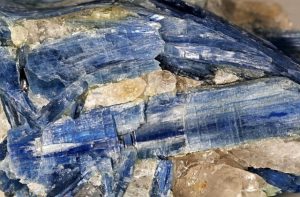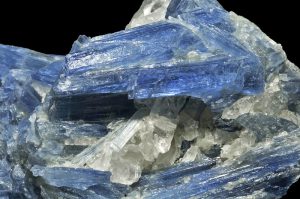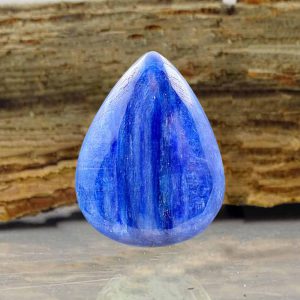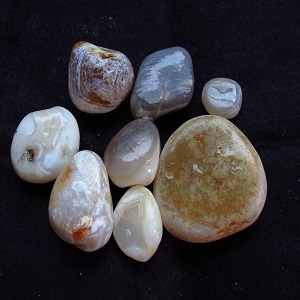Kyanite, its uses and properties

Kyanite is a stone of aluminum silicate which is named as Kyanite, Disthene and Rhaeticite.
Its name is derived from the Greek word Kanos or Kianos meaning deep blue (screaming blue) and the color of this stone.
In addition to blue color, this stone can be colorless, white, gray, green, orange and yellow.
It is usually found in pale blue, indigo, green, black and white colors;
However, sometimes this stone can be seen in orange, gray, pink and yellow colors.
The origin of the name Kyanite
The name kyanite stone is derived from a Greek word meaning blue.
The color in kyanite stone may not be evenly distributed and it is possible to see a range of light to dark color in this stone.
This stone is composed of andalusite and sillimanite.
Mixed rocks usually have the same chemical composition but different crystal structures.
For example, the crystal structure of this stone is triclinic, while andalusite and sillimanite both have angular structures.
Most of the stones have heterogeneity in structure, but this heterogeneity is seen very much in kyanite stone.
When we cut this stone parallel to its longitudinal axis,
Its hardness is between 4.5 and 5, while if the stone is cut in the width axis, its hardness is variable and is around 6-7.
Detection of kyanite

Kyanite stone belongs to the family of aluminosilicates and has very special heterogeneity properties.
This stone can be recognized by its double degree of hardness.
Many materials have variable hardness in their crystal plates, but in this stone, this heterogeneity can be seen in all its crystals.
For this reason, this stone is easily recognized.
The origin and source of kyanite
This stone can be found in all parts of the world such as Austria, Burma, Brazil, India, Colombia, Nepal, Kenya, Myanmar, Serbia,
Switzerland, Tanzania, America found in North Carolina, Georgia and Pennsylvania and Zimbabwe.
In recent years, orange kyanite has been discovered in Zimbabwe, and large pieces of its crystals have been found in the Omba Valley in Kenya.
One of the best sources of kyanite in the world is Nepal, whose blue color easily competes with Madagascar sapphire.
Kyanite color
Kyanite generally appears in different shades of blue, but rarely white, gray, green, yellow,
We can also see the orange and the colorless sample, which is the rarest type (its rarity is not the reason for its value).
The popular and welcome color of this stone is blue, but usually the colors are distributed heterogeneously in this stone.
This heterogeneous distribution is seen in most rocks.
The veins in this stone can appear white or in other colors
Clarity and brilliance of kyanite stone

Kyanite stones can be transparent and semi-transparent, usually the transparent type is more popular with the public.
Almost all kyanite stones cause vision errors due to their color spread.
Kyanite stones above 2 carats are among the rare stones.
The best time to see this stone is in daylight.
In terms of luster, this stone has a glassy to pearly appearance that shows itself when polished or cut.
Appearance and cut of kyanite
Transparent kyanites have a polyhedral cut and semi-transparent samples have a curved cut.
There is a type of kyanite called cat’s eye, which is cut in a curved shape.
Since the hardness of this stone varies depending on the cutting direction, as a result, the cutting direction should be taken into consideration.
The most common shapes of this stone are oval and pear-shaped.
There are other shapes such as round, heart, etc. in the cut, and if such cuts are made, the work will be paid more.
Kyanite processing
Usually, this stone is not subjected to any operation, but nevertheless, in some special areas, synthetic oils and fats are used to polish the stone more.
Sometimes in buying and selling, this stone is sold instead of a sapphire.
Petrological properties of kyanite rock

Chemical formula: aluminum silicate Al2O [SiO4] Crystal structure: triclinic, long, flat prisms
Color: blue to colorless, blue green and brown
Hardness: 4-4.5 in the length axis and 6-7 in the width axis
Refractive index: 1.710-1.734
Density: 3.53-3.70
Cleavage (tendency of rock to fracture along a preferred direction in parallel planes): complete
Transparency: semi-transparent to transparent
Light refraction: -0.015
Luster: pearly-glassy
Fluorescence mode: weak: red
Similar or related stones
Kyanite is a stone that looks like a combination of andalusite and sillimanite.
All three types of these stones are aluminum silicate, while kyanite has triclinic crystals and the other two stones have angular crystals.
This difference in crystal structures is due to the geological conditions during the formation process of these stones.
Kyanite is formed at a lower temperature and in environments with higher air pressure.
Andalusite is formed at low temperature and low air pressure and sillimanite at higher temperature and higher pressure.
Kyanite stone is confused with sapphire and topaz.
In addition to sapphire, andalusite, sillimanite and kyanite are formed in conditions close to quartz, talc (magnesium silicate), albite (white feldspar) and almandine.
Ideas for designing kyanite jewelry

In making jewelry, they use kyanite stone instead of sapphire (because of its low price in comparison), but because of the varying hardness of this stone and its cleavage.
It cannot be said that it is a widely used stone in making jewelry.
Since the hardness of this stone is related to the type of cut, its best use is in making earrings and necklace pendants, which are not used every day like bracelets or other jewelry.
This sink looks best in white gold or silver. Kyanite is one of the reasonably priced stones that has a very beautiful appearance.
For designs with more shine, it is cut in a multi-faceted manner, of course, sphere or bead cutting is also common for this stone.
In addition to being used in jewelry, this stone is used in making glass, electric sockets, thermal conductors, and thermal elements.
It is also used in the ceramic industry, especially ceramic dishes and porcelain pipe fittings.
Tip: When buying precious stones, pay more attention to their size than their carat weight.
Kyanite maintenance and cleaning
This stone is relatively durable, but compared to other stones, it is a little more fragile.
Like diamond and topaz, it has complete cleavage and therefore it can break with the least impact.
It is softer than diamond, sapphire and many other stones and it is better not to keep it next to other stones to avoid scratches.
Do not use bleach or acid to clean it and only use soap and water and a soft cloth.
Make sure that before drying the stone, rinse it well to remove the alkaline soap deposits from it.
Before doing sports activities, washing dishes, gardening activities or doing housework, remove the jewelry decorated with this stone.
When removing the ornaments, do not remove them from the stone section because this gradually loosens the connection between the stone and the base and eventually causes the stones to fall.
The best way to store it is in a soft cloth or in a gold and jewelry box covered with cloth.




